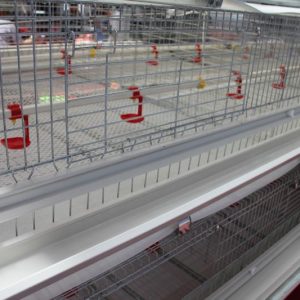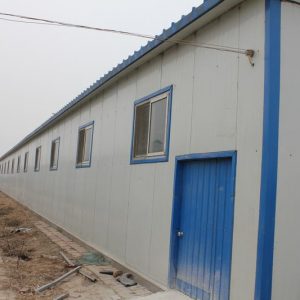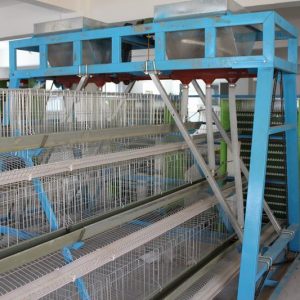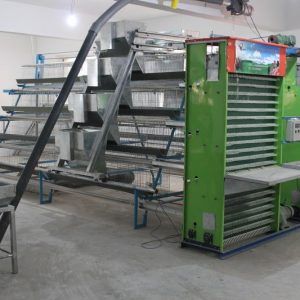
Large-scale scientific chicken breeding technology
1. Choice of venue
To build a chicken farm, we must first consider the issue of site selection. The site selection must be based on the scale and nature of the chicken farm (raising commercial broilers, commercial laying hens or breeders, etc.). Whether the site selection is appropriate is related to Sanitation and epidemic prevention, chicken growth, and the work efficiency of breeders are related to the success or failure of chicken raising and the benefits.
Site selection should consider comprehensive factors, such as area, topography, soil, orientation, traffic, water source, power supply, epidemic prevention conditions, natural disasters and economic environment, etc. The general site selection should follow the following principles.
(1) is conducive to epidemic prevention.
(2) The site should be in a tall, dry and well-drained place.
(3) There must be shade in the venue.
(4) The venue must have water and power sources.
(5) The area of the venue must be circled.
2. Chicken house construction and equipment
(1) In order to prevent the weasel, fox, dog and other animal damages, it is necessary to build chicken coops. Construction of fixed chicken coops for ecological free-range chickens:
The layout of the chicken farm should first consider the environmental protection of people’s work and living places, so as to avoid the pollution of feed dust, fecal smell and other waste as much as possible. Secondly, it is necessary to pay attention to the epidemic prevention and sanitation of the production chickens, and try to eliminate the possibility of pollution sources to the environment of the production chickens. The epidemic prevention environment of chicken flocks should be paid special attention to comprehensive chicken farms. The chicken flocks should also be divided into communities with certain isolation facilities, and good ventilation effects should be maintained.
1. The general chicken farm can be divided into 5 areas, namely, staff living area, administrative management area, auxiliary production area, chicken breeding area (production area), sick chicken and fecal sewage treatment area.
2. The division of chicken farms should be tailored to local conditions, arranged according to local natural conditions-topography, traffic roads, etc., and planned according to the height of the terrain and the prevailing wind direction to facilitate the epidemic prevention of chicken farms.
3. The production area and the living area must be strictly separated, and the feed storage and brooding houses should be built in the upper limelight of the chicken farm. The sick chicken necropsy room, the sick and dead chicken incinerator, and the manure disposal site should be placed at the bottom of the chicken farm, and transported outside the fence by special vehicles and dedicated roads, and fermented in the processing site (ground).
4. The egg tray and egg box disinfection pool should be built on the same parallel line with the wall of the production area. The return egg tray vehicles are parked outside the fence and the egg trays and egg boxes are directly sent into the disinfection pool containing 0.3 9/5~0.59/5 peroxyacetic acid solution or 2% caustic soda water for 4-6 hours. Then take it out, wash and set aside.
5. The gate of the chicken farm and the production area should build a disinfection tank that is wider than the door and one and a half weeks longer than the wheel of the car, and the workshop enters a disinfection tank that is 1.5 meters wider than the door and is 1.5 meters long. The production area door VI must also build a dressing room and a shower room (a mandatory shower device is required).
6. Poultry farms with conditions should build their own deep wells or water towers, and pipe water directly to the chicken house.
7. A storage warehouse shall be established, and feed shall be delivered directly to the warehouse by a feed truck.
(2) Chicken raising equipment and utensils
1. Chicken coop is the main equipment of caged chicken house. There are chicken cages, brood cages, and layer cages.
2. Feeding equipment includes feeding machinery and troughs. There are chain feeders, plug tray feeders, and troughs.
3. Drinking water equipment. Trough drinker, tower vacuum drinker, nipple drinker
3. Feeding management of free-range chickens
Must choose the right brooding season to facilitate the grazing of ecological chickens. It is best to brood in March to May, and the survival rate of brooding is high during this period. In the middle chicken stage, due to the suitable temperature and long time outside the house, sufficient exercise and exercise can be obtained, so the physique is strong, which is very beneficial to natural grazing and feeding and preventing natural enemies in the future. The spring chicks are sexually mature early, and the laying time is long, especially the chicks that hatch in the early spring are better.
The feed for ecological chickens must be organic feed. Therefore, when planting ecological chicken feed ingredients, they must meet the requirements of organic food, and artificially fed animal feeds must also be implemented in accordance with the standards for organic food production. It is strictly prohibited to add chemicals during the production of artificial feed to ensure the quality of ecological chickens. The quality of natural feed depends on the natural environment, mainly including natural forage, mature seeds and various natural insects. Only with sufficient natural feed and comprehensive nutrition for ecological chickens can we produce high-quality products with high nutritional value and strong nourishment.
Fourth, prevention and treatment of common diseases of free-range chickens
1, viral diseases
1) Newcastle disease and infectious bursal disease Newcastle disease and infectious bursal disease are the main infectious diseases that affect the survival rate of stocking chicks. This is because: ① Most of the chicken breeds raised in free-range chickens are local chickens, and the immunization procedures of various chicken farms are very different, and the initial immunization time is difficult to determine. ② Applying modern broiler and layer immunization procedures, immunization procedures are unreasonable, improper immunization methods, etc., are susceptible to infectious bursal disease, which is manifested by the inability to produce the necessary antibodies after the Newcastle disease vaccine, resulting in immune failure. ③ Lack of nutrients in the diet and poor feeding management, such as sudden changes in environmental temperature and excessive feeding density, will affect the immune effect. During the stocking period, free-range chickens are often immunized by drinking water when immunized due to the particularity of their breeding environment. Drinking water methods often cause uneven drinking water due to large groups; chickens eat green feed and drink water from potholes, and drinking water decreases, which directly affects drinking water and immune effects, and sporadic Newcastle disease often occurs. Although a large-scale epidemic has not been found in the investigation, sporadic atypical Newcastle disease is still one of the diseases that endanger free-range chickens. This is because sporadic atypical Newcastle disease mostly occurs in immunized chickens, the disease is relatively mild, the morbidity and mortality are not high, and it often induces other diseases, accompanied by colibacillosis or chronic respiratory diseases, and is often affected by other diseases. The concealed appearance of symptoms often does not attract people’s attention, and causes greater losses in production. Enough attention should be paid in production.
2) Marek’s disease For many years, people have generally thought that local chickens have strong disease resistance and do not need to be vaccinated against Marek’s disease. However, the investigation found that Marek’s disease can also cause huge losses to local chickens. The main reason is that when some free-range chicken farms buy commercial laying hens to identify chicks, they do not declare that they require Marek’s disease vaccines, and second, they only pay less for immediate benefits and do not vaccinate Marek’s disease vaccines. The chickens were wasted and died in the area, and Marek’s disease was discovered after inspection. But it was too late, not only causing huge economic losses, but also extremely detrimental to the epidemic prevention in the coming year. Through the investigation of free-range chicken farms, it was found that no cases of Marek’s disease vaccine were found in local chickens or specialized supporting breeds. However, individual chicken farms that were not vaccinated against Marek’s disease vaccine had larger scales and better breeding management. The worse the field, the higher the morbidity and mortality rate, the highest can reach 20% to 30%.
3) Respiratory diseases During the brooding period, it was found that during the brooding period, respiratory diseases, such as infectious bronchitis, were often caused by excessive stocking density, poor ventilation, fluctuating temperatures, and poor sanitary conditions. In the stocking stage, in spring, summer and autumn, the ventilation conditions inside and outside the house are good, so there is generally less respiratory disease. In winter, ventilation is neglected in order to keep warm, resulting in increased concentrations of dust, ammonia, and hydrogen sulfide in the house, and respiratory diseases sometimes occur.
4) Chickenpox Free-range chickens are generally raised in woodlands, fields, and grasslands. Moist grassland and woodland are places where mosquitoes and flies breed, and there are many mosquitoes and flies in the surrounding environment, which are susceptible to the disease. Crowding, poor ventilation, dark and humid, vitamin deficiency and poor feeding and management can make the condition worse. If it is accompanied by staphylococcal disease and infection, it can cause a large number of chicken deaths. Although no widespread epidemic was found in the survey, the infection rate of chickenpox in individual chicken farms was more than 20%. The focus of prevention is to improve environmental sanitation and eliminate the breeding of mosquitoes and flies; the other is to stab the breeder pox vaccine before the fall.
2, bacterial diseases
1) Salmonellosis During the investigation, it was found that Salmonella is one of the causes that seriously harm the survival rate of chicks. Pullorum disease is particularly prominent in free-range chickens, because some breeder farms have not been purified for pullorum disease. One is that the infected chickens are passed on to the next generation through breeding eggs; the other is the incubation conditions and sanitary conditions of the breeder hatchery. Poor management, resulting in horizontal transmission; third, poor brooding conditions in stocking chicken farms, fluctuating temperatures, poor sanitary conditions, and easy to induce the disease; fourth, preventive medication cannot be administered on time. These factors are the main reasons for the high mortality during the brooding period of free-range chickens. Therefore, during the brooding period, feeding 3 to 7-day-old chicks with an appropriate amount of antibacterial drugs can significantly reduce the incidence of pullorum disease in chicks and increase the survival rate of chicks.
2) E. coli disease E. coli is a conditional pathogen. During the brooding period, poor feeding management, dark and humid chicken houses, poor ventilation, poor environmental sanitation and other adverse factors can reduce the resistance of chickens and induce or Promote the occurrence of coliform disease. The disease can occur all year round, but it is more common in seasons with changing temperatures. Due to the particularity of the environment, free-range chickens are often exposed to contaminated feed, drinking water, utensils, etc., moldy and deteriorated feed, and affected by external stress factors (rain, temperature changes, etc.), and are susceptible to infection or concurrent E. coli Escherichia coli disease is one of the most susceptible and most harmful infectious diseases in free-range chickens. The disease occurs throughout the entire feeding cycle, and is often concurrently infected with certain diseases, or secondary to the epidemic of certain diseases, and its harm is very serious.
3, parasitic diseases
1) Coccidiosis Coccidiosis mainly occurs in chickens under 3 months of age. Among them, 15 to 45 days of age are most susceptible to infection, with high morbidity and mortality. Free-range chickens touch the ground, and feed, drinking water, and land contaminated by diseased chicken feces are the main vectors of the disease. Hot and rainy days, overcrowded chickens, too wet sports grounds, mixed breeding of large and small chickens, lack of vitamin A in the feed, and improper rations are all factors that induce the epidemic. In the investigation, although the death rate was not too high, there were cases in every field. A combination of feeding management and drug prevention can achieve good results.
2) Nematode and tapeworm disease Nematode and tapeworm disease are common parasitic diseases. Most free-range chicken farms can achieve regular deworming, but sometimes the feces cannot be cleaned up in time, piled up and fermented, and cleaned of dirt in the farm, which makes the eggs “relay”, thus failing to achieve the expected results. Therefore, regular drug deworming must be done.
4, others
1) Pecking addiction is often due to the polyculture of chickens that are too large, different breeds, ages, and strengths; improper rations, lack of certain nutrients, especially protein feed, calcium, insufficient salt or certain vitamins Lack of trace elements; insufficient feeding and irregular time can cause pecking.
2) Nutritional deficiencies cause malnutrition in stocked chickens due to the following factors: suffering from certain parasitic diseases; because the flocks are too large, there are too few troughs and water troughs, and the layout is not appropriate; the amount of feed is insufficient and the time is too short Or inappropriate, improper diet mix; poor pasture vegetation and overloading may cause malnutrition, reduce the tidiness of chickens, delay time to market, and reduce economic benefits.
5. Comprehensive prevention and control measures for free-range chicken disease
“Prevention first, combination of prevention and treatment, prevention is more important than cure” is the basic policy of chicken disease prevention. The spread of infectious diseases of chickens in chicken flocks must have three interconnected conditions, namely, the source of infection, the route of transmission and the susceptible flocks. When these three conditions exist at the same time and are interrelated, it will cause the occurrence and prevalence of infectious diseases. Therefore, to control these diseases, we generally start from the following aspects: The first is to create a suitable environment for chickens, that is, chicken house construction, breeding management technology; the second is to eliminate external pathogens, that is, disinfection technology; Build a strong immune barrier inside, that is, immune technology; the fourth is to do a good job of preventive drug administration during the susceptible period of chickens. When infected with diseases, timely diagnose and use appropriate drugs to eliminate pathogens and make chickens recover, that is, prevention, diagnosis and treatment technology.
1. The layout and construction of the chicken farm should be reasonable. The chicken farm should be built in an area with high dryness, good drainage, ventilation, and isolation conditions, and there are no pollution sources such as chemical factories and mining farms around. Keep away from towns, residential areas, urban drinking water sources, schools and other public places, and isolation belts should be built around them. Implement an all-in, all-out system, and at least each chicken house raises the same batch of chickens of the same age. The production area of the chicken farm is separated from the living area, and the chicks are raised separately from the free-range chickens. The hen house construction should meet the sanitary requirements, while facilitating the feeding and management of heatstroke prevention, cooling, ventilation, and lighting. The chicks are raised in cages or online. The stocking shed generally raises 300-500 animals per house, and build perches and laying boxes in the house.
2. In terms of breed selection, introduce high-quality chicken breeds suitable for stocking. High-quality chicken breeds that are suitable for market sales, wide adaptability, and strong disease resistance should be selected, such as Shiqi Za, Gushi Chicken, Sanhuang Chicken, etc. Breeder farms should choose breeder farms that have been purified for pullorum disease and leukemia, have good breeding management, good hatching conditions, and high reputation. At the same time, a Marek’s disease vaccine is required.
3. Strengthen breeding management. Modern large-scale free-range chickens are different from the previous backyard chickens. First of all, chicken farmers should undergo professional training, pay attention to technical updates, and overcome management inertia. Master the appropriate temperature, humidity, light, ventilation and density. According to the stocking density, vegetation status, feed intake and the growth and development of chickens, rationally formulate feed and adjust supplementary feed. Adding microecological agents to feed can improve the body’s disease resistance. Frequent observation of chicken flocks, production records, so that diseased chickens can be found in time. The sick chickens should be isolated and treated in time. Strictly shut down the feed, and reject contaminated or moldy feed. Strengthen the harmless treatment of sewage, feces, and dead chickens. Pay attention to weather changes and reduce various stresses.
4. Scientifically formulate immunization procedures and correctly choose the use of vaccines. The ultimate goal of immunization is to maintain protective antibodies in the body of poultry during the entire production and growth process. Therefore, immunization procedures should be formulated according to the principles of immunology to treat poultry before and after immunization. Carry out antibody monitoring, under the premise of fully understanding the true immune status of the flock, and then combine the local and surrounding environmental disease epidemic situation to determine the best time for vaccination. The maternal antibody level is the main basis for determining the age of the first immunity. Chicken farmers who do not have monitoring conditions should check with the breeder factory that supplies the chicks, and then determine the time of the first immunity, and do not blindly apply ready-made immunization procedures. At present, there are many kinds of vaccines on the market, and the potency and quality are different. The vaccines with reliable quality should be strictly selected. When using the vaccine, you should strictly follow the instructions for use of the vaccine. Do not be careless. Do not change the injection site, dilution concentration, immunization dose, and vaccination route at will, so as not to affect the immune effect.
5. Strict sanitation and disinfection measures Strict sanitation and disinfection measures are as important as vaccination. Many experiments have shown that raising chickens in a sterile (viral) environment does not necessarily cause disease even if the antibody level of the chickens is very low; on the contrary, when there are a large number of pathogens in the environment, they can attack chickens with low antibody levels at any time. Cause disease. Therefore, we should do our best to eliminate pathogens in the breeding environment, prevent external pathogenic microorganisms from invading chickens, cut off the transmission route, and prevent the occurrence and spread of infectious diseases. Disinfection is an important measure.
6. Diagnosis and treatment of epidemic diseases Fast and accurate diagnosis is the basis for providing treatment, and it is also an important link in controlling the spread of the disease and reducing the loss of disease. As the breeding and management personnel of the chicken farm, we must carefully observe the chickens in order to find problems in time. In chicken’s



